ISSN ONLINE(2278-8875) PRINT (2320-3765)
ISSN ONLINE(2278-8875) PRINT (2320-3765)
Er. Piyush Vyas1 and Er. Tejas Maniar2
|
| Related article at Pubmed, Scholar Google |
Visit for more related articles at International Journal of Advanced Research in Electrical, Electronics and Instrumentation Engineering
In this paper, we consider orthogonal space- frequency detection schemes for OFDM systems in broadband wireless channels. This paper proposes a compensation method to prevent error floor caused by unequal sub channels in the space-Time block coded OFDM systems for 1 and 2 transmit antennas in different parameters while providing diversity gain. This paper will show that for 1×1 & 2×2 antennas cases like JML, ZF, SML, DF etc, the proposed compensation method gives the zero forcing solution. Proposed paper and techniques compare the method with the space time block coded OFDM systems with respect to broadband wireless channel specifications in form of BER calcutions. It also shows the channel compensation method with sub division of wave forms that can be performed during the channel estimation using a Kalman filter.
Keywords |
| OFDM, space-frequency block code, channel compensation, error floor. |
INTRODUCTION |
| Orthogonal Frequency Division Multiplexing (OFDM) is a digital detection technique who consists of transmitting a unique data stream using a large number of parallel narrow-band sub carriers instead of a single wideband carrier additionally, assuming sufficient cyclic prefix (CP), the performances of all systems in spatially uncorrelated time-varying multipath Rayleigh fading channels are evaluated by theoretical derivation and computer simulation, as well. Numerical results have revealed that significant performance improvement can be achieved even when the systems are operated in highly selective channels. |
| Space-time block coding (STBC) or transmit diversity block coding (TDBC), an effective transmit diversity technique, was first proposed by Alamouti [1] for flat fading channels. Recently, Vielmon et al. investigated the impact of a time-varying channel on the performance of Alamouti scheme. In addition to the simple maximum-likelihood (SML) detector, originally proposed by Alamouti, et al. also recommended four novel detectors to combat the rapid channel variation and hence to obtain better performance. These detectors are the zero-forcing (ZF), the decisionfeedback (DF) and the joint maximum-likelihood (JML) detectors [2]. According to Alamouti code, Lee et al. proposed three combinations of TDBC and OFDM [3] [4], i.e., space-time block coded OFDM (STBC-OFDM) [5] and space-frequency block coded OFDM (SFBC-OFDM) [6]. Nevertheless, they employed the SML detector, which was designed under the assumption that the channel is static over the duration of a space-time/ narrow band frequency codeword. Consequently, STBC-OFDM/ SFBC-OFDM suffer from the high time/frequency-selectivity of the wireless mobile fading channel. In this paper, in addition to the original SML detector, three novel detectors mentioned earlier are applied to improve the two-branch TDBC-OFDM systems. Additionally, assuming sufficient CP, the performances of STBC-OFDM and SFBC OFDM systems with the original and the novel detectors in spatially uncorrelated timevarying multipath Rayleigh fading channels are evaluated by theoretical derivation and computer simulation, as well. Based on applying the concept of “effective signal-to-noise ratio (SNR)” to the results in [2], the derived bit-error-rate (BER) expressions can provide useful insights. Li et al. derived a simple expression for the tight upper bound on the variance of the ICI of previous content [4]. In consequence of this expression, analytical results are easy to calculate. Numerical results have revealed that significant performance improvement can be achieved even when the systems are operated in highly selective channels. |
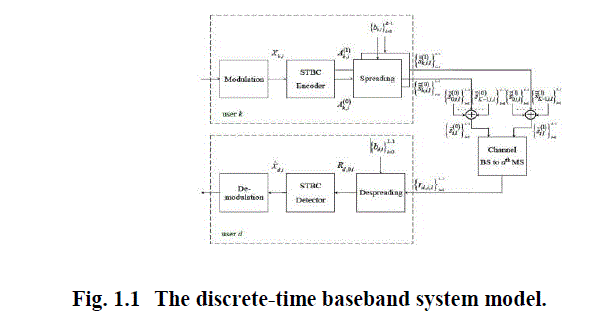 |
SYSTEM MODEL |
| In this paper, we consider the wireless mobile communication techniques of OFDM transmit diversity systems using Alamouti code with dual transmit antennas at the base station and single receive antenna at the remote end in the downlink transmission. The discrete-time baseband equivalent system model of the two-branch TDBC-OFDM systems is depicted in Fig.1. |
 |
| In addition, the comparison between STBC-OFDM and SFBC-OFDM systems is shown in Fig. 1.2. |
SYSTEM FUNCTIONING OFDM TRANSCEIVER |
| In this section, we describe the OFDM transceiver system. Before transmitting information bit over an AWGN channel through the OFDM transmitter, the data stream may use the M-PSK and M-QAM modulation schemes shown in Fig.1.3. The transmitter section converts the digital data to be transmitted, into a mapping of the sub-carrier’s amplitude and phase using modulation techniques. |
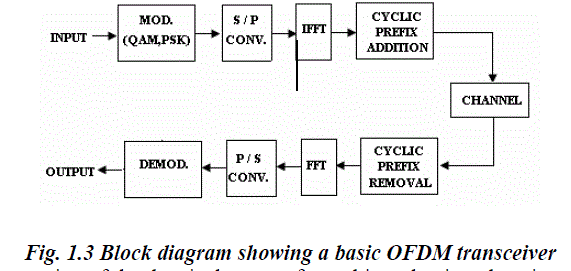 |
| The spectral representation of the data is then transformed into the time domain using an IFFT which is much more computationally efficient and used in all practical Systems . The addition of a cyclic prefix to each symbol solves both ISI and inter-carrier interference (ICI). The digital data is then transmitted over the channel. After the time-domain signal passes through the channel, it is broken down into the parallel symbols and the prefix is simply discarded. The receiver performs the reverse operation to that of the transmitter. The amplitude and phase of the sub-carrier are then selected and converted back to digital data. In OFDM, multiple sinusoidals with frequency separations 1/T are used, where T is the active symbol period. The information to be sent on each sub-carrier k is multiplied by its corresponding |
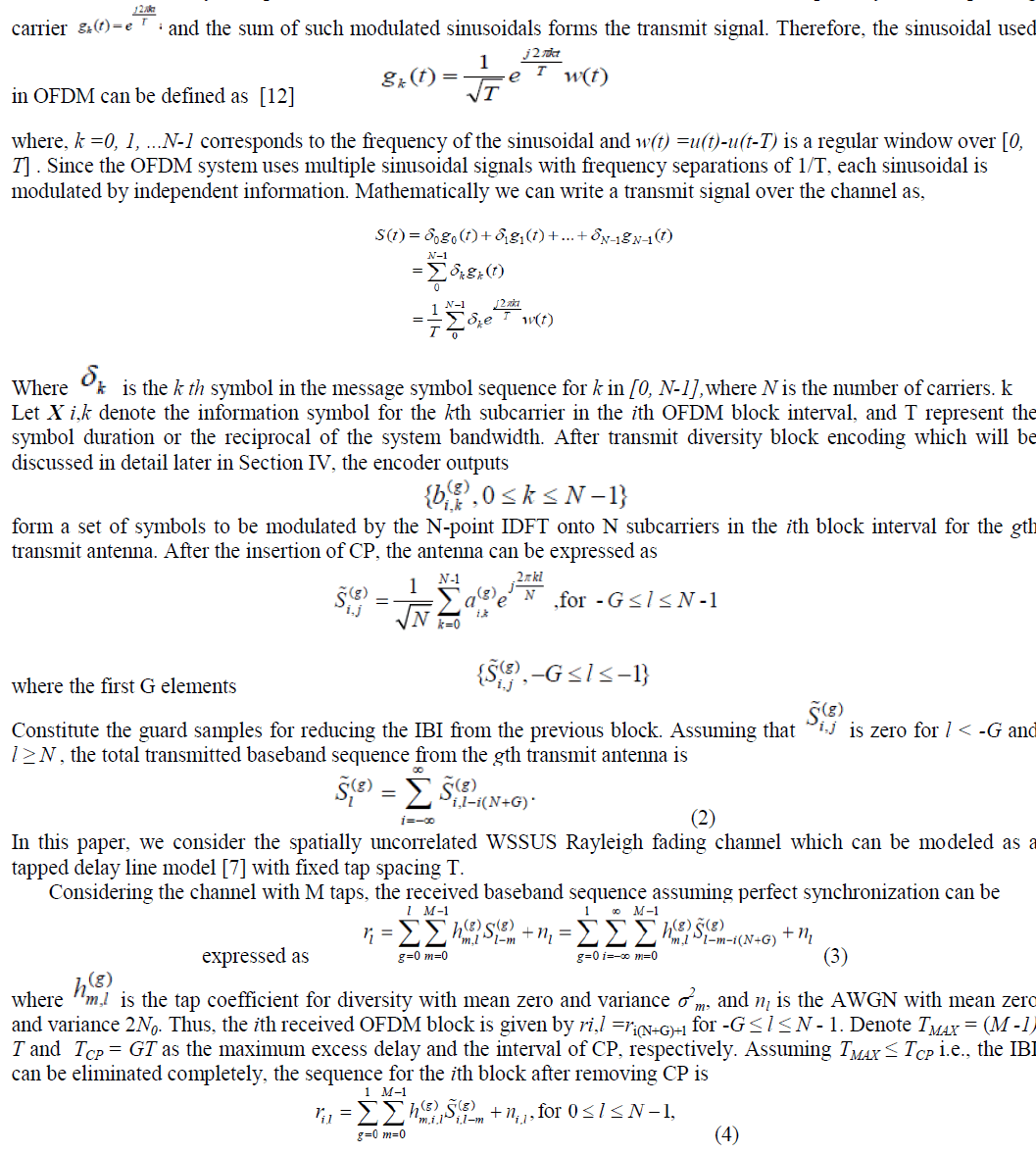 |
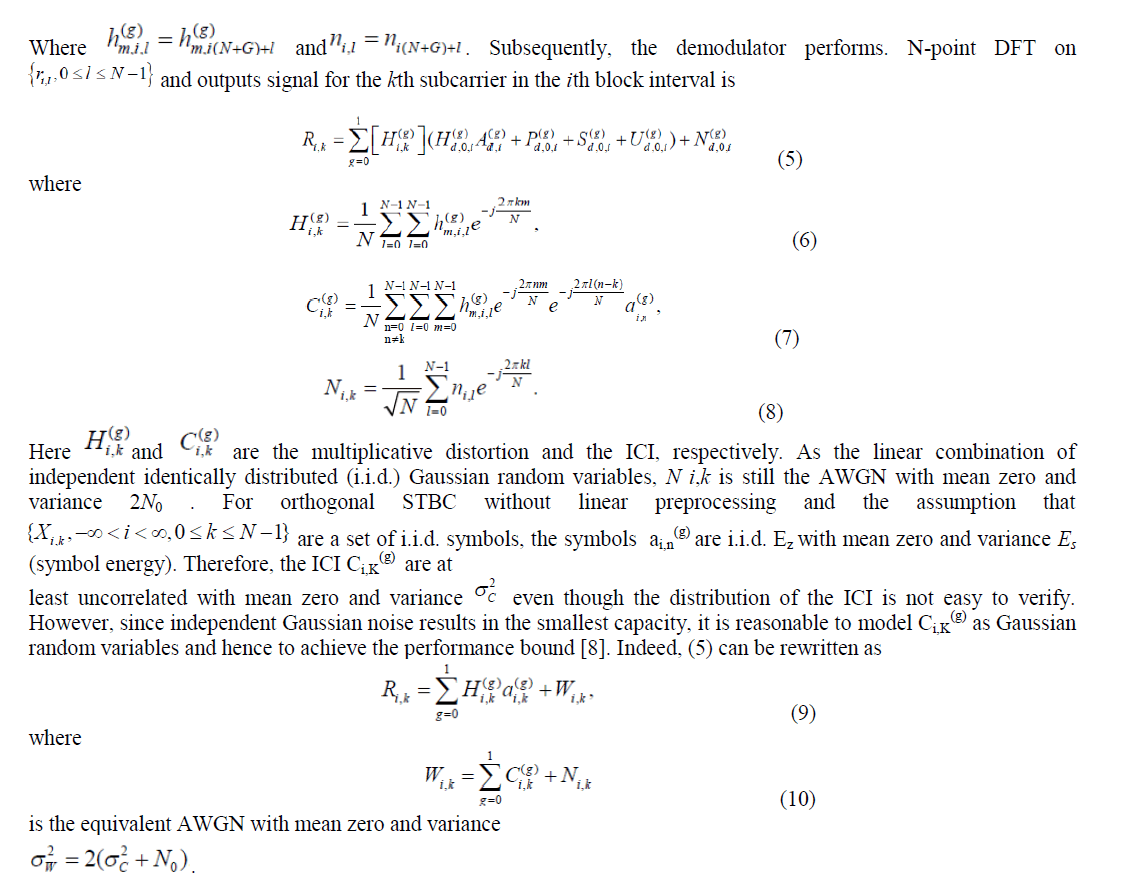 |
STATISTICAL PARAMETERS PROPERTIES |
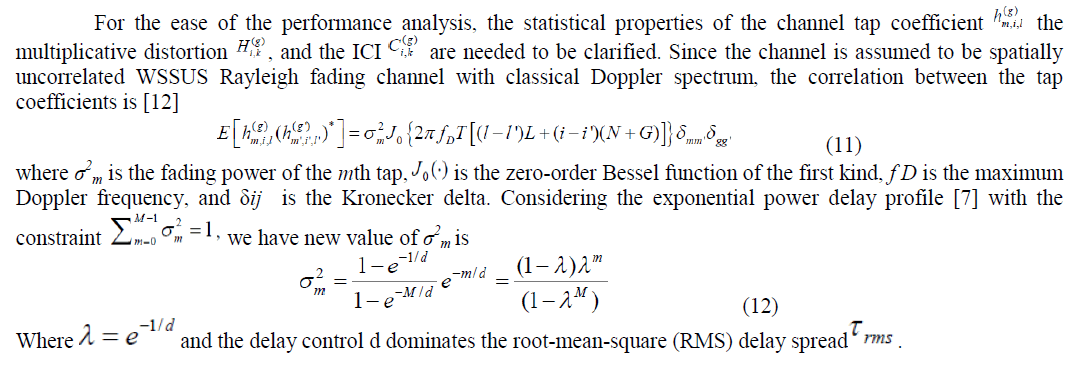 |
| PAPER WORK AND OBJECTIVE: Analysis & study of the effects of filtering on the performance of a proposed SFBC and STBC OFDM scheme on Random and fixed parameters of x input on for 1×1 & 2×2 antennas with auto correlation, JML, ZF, DF etc for the OFDM system then they are not the same because each OFDM symbol contains an additional overhead in both the time and frequency domains. In the time domain, the cyclic prefix is an additional over we head to each OFDM symbol being transmitted. To overcome this and improve system performance, a simple effective method of Non coherent & coherent approaches we use scatter plots of all these schemes [13]. |
| (i) Correlation of the Multiplicative Distortion: |
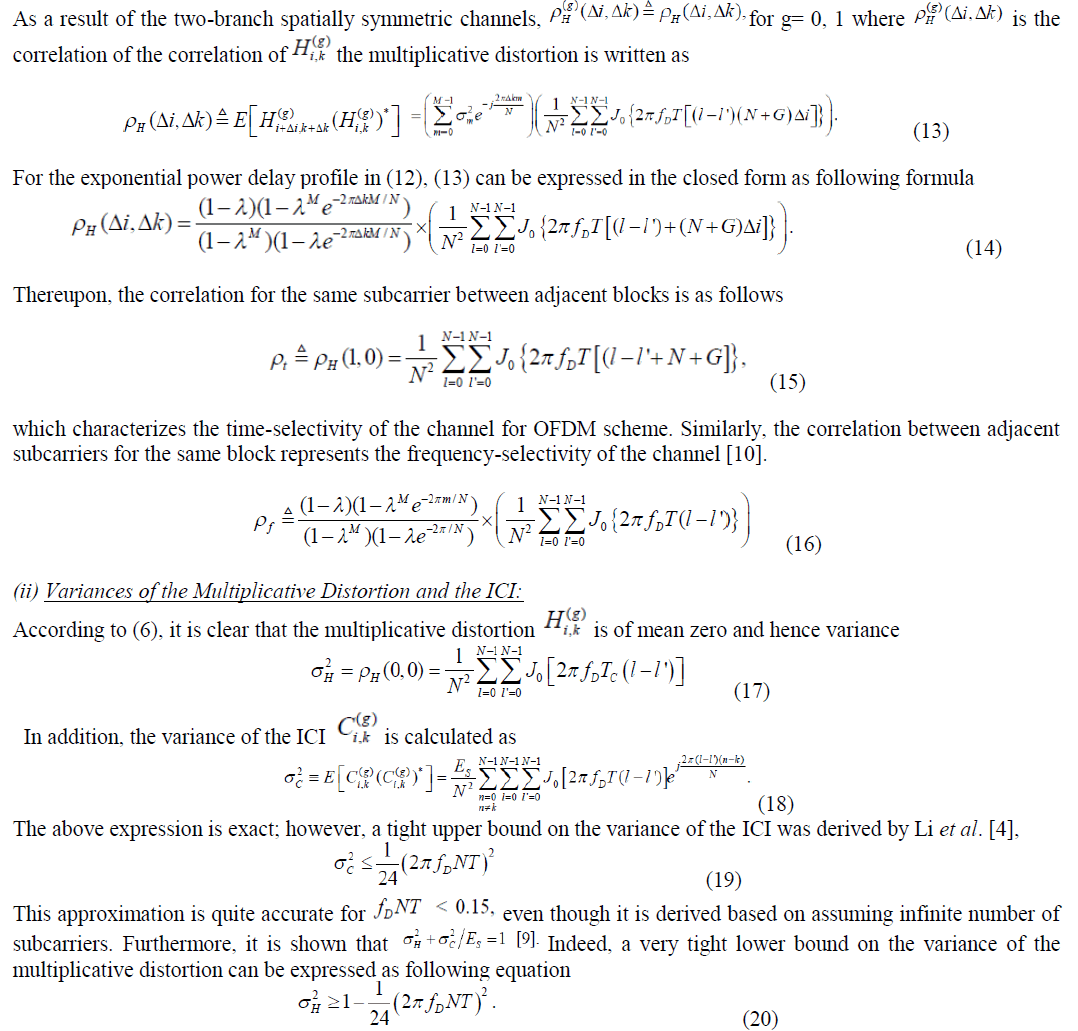 |
A. STBC-OFDM: |
| Following matrix shows Space Time Block Codes format as |
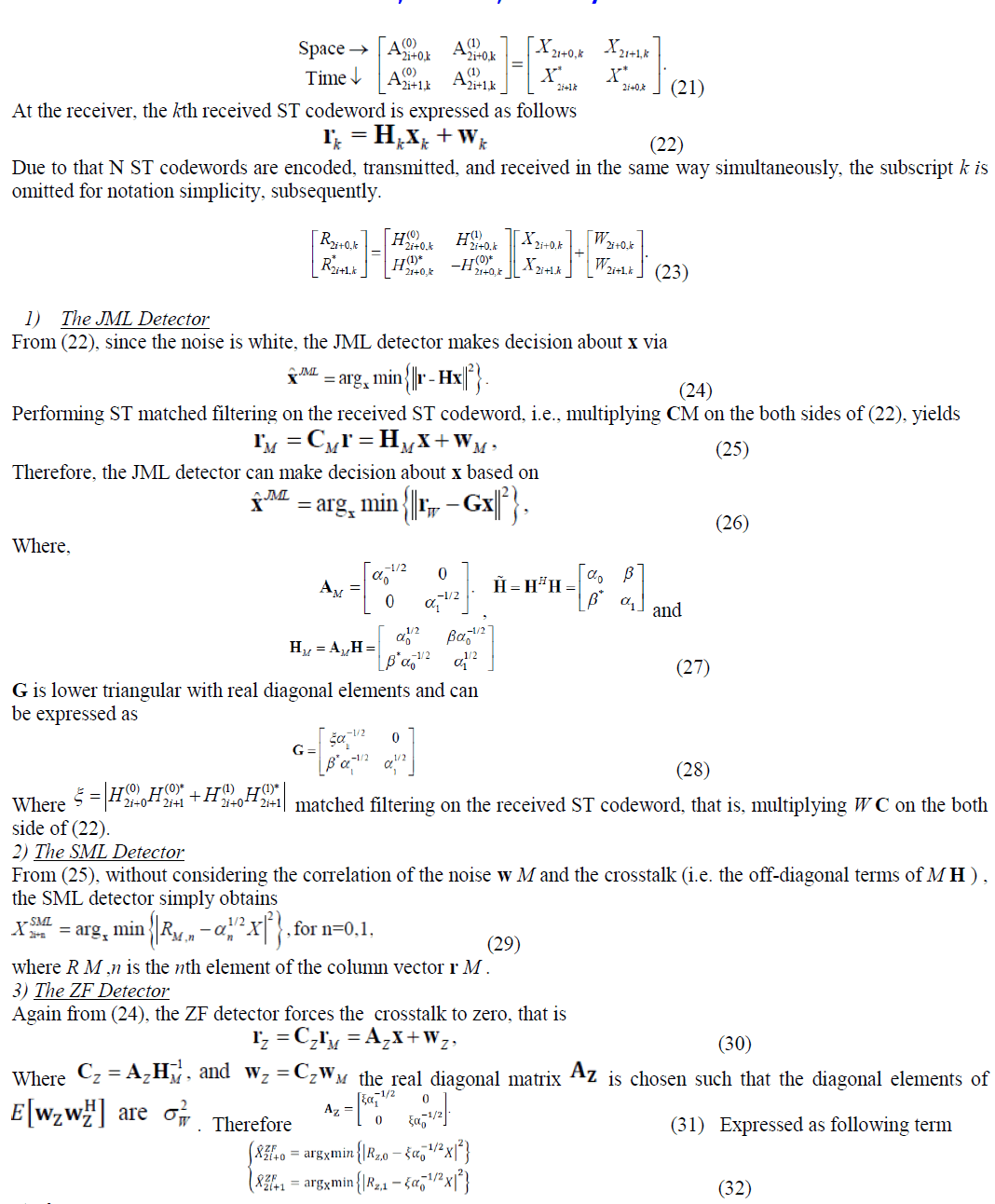 |
| 4) The DF Detector |
| From (25), the DF detector uses a decision about X2i + 0 to X2i + 1 help make a decision about, namely, |
 |
| The main objective of this paper is to develop and discuss a method based on transceivers that provides a simple but effective calculation and performance through detection techniques with splitting frames in bit error rate (BER) performance which is required in modern broadband wireless transmission OFDM systems. |
| B. SFBC-OFDM: The derivation of the BERs of SFBC-OFDM is similar to that of STBC-OFDM for evaluation of detection techniques, and the results are summarized as follows. Firstly, the performance bound of the JML detector for SFBC-OFDM are the same as that for STBC-OFDM. Secondly, the theoretical BERs of the other detectors for SFBCOFDM systems are in the same forms as that for STBC-OFDM systems, expect for using as the corresponding correlation. Firstly, only when the channel is both frequency-nonselective and quasi-static, the performance of all the detectors for SFBC-OFDM systems can meet the matched filter bound in (33). |
| V. Simulation Results: For all simulations through MATLAB simulator, the parameters are detailed as follows. Firstly, the carrier frequency and the system bandwidth are 1.8 GHz and 800 KHz, respectively, and thus the symbol duration is T = 1.25μ seconds; secondly, the number of subcarriers and CP are N = 128 and G = 32, respectively, and hence the total OFDM block duration is (N+G)T=200μ seconds; thirdly, the number of uncorrelated paths is M =12 ; finally, the modulation is BPSK. the analytical error floors for STBC-OFDM and SFBC-OFDM systems, respectively. The reasons for the presence of these error floorsare two-fold: 1) the ICI induced when the channel is not constant over an OFDM block duration; 2) the crosstalk resulted from the channel variation over the duration of a ST/SF codeword. |
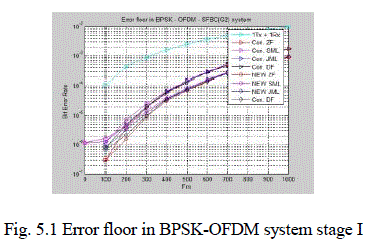 |
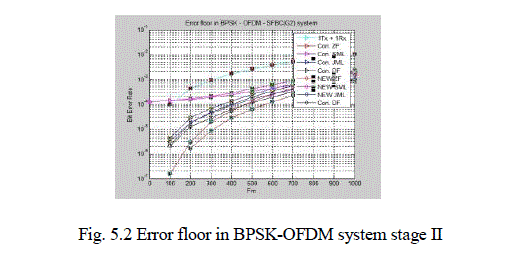 |
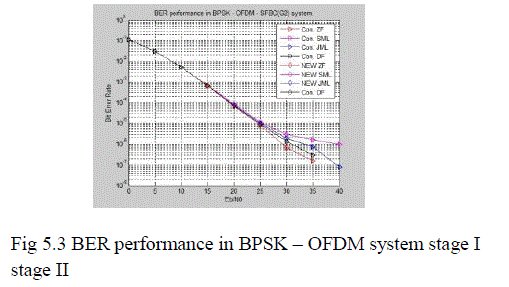 |
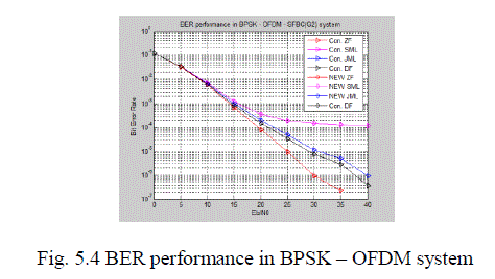 |
CONCLUSION |
| In this paper, in addition to the original SML detector, three novel detectors are applied to improve the twobranch TDBC-OFDM systems. To combat the crosstalk resulted from rapid channel selectivity, the ZF detector just forces the crosstalk to zero, the DF detector alleviates the crosstalk by whitened-matched filtering, and the JML detector reduces the crosstalk and the noise simultaneously. Thereupon, the JML detector is of the best performance but highest complexity, while the DF and the ZF detectors are of poorer performance but less complexity. Moreover, assuming sufficient CP and BPSK modulation, we derive the theoretical BERs for TDBC-OFDM systems in spatially uncorrelated time-varying multipath Rayleigh fading channels. |
References |
|